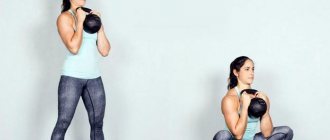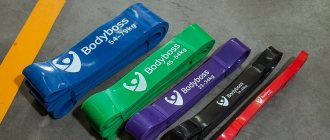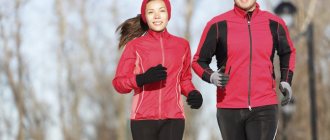Is it possible to exercise during menstruation? There is a lot of discussion around this issue. Both the ban and the permission are defended. Menstruation is always accompanied by changes in mood and well-being. PMS pain is present. However, menstruation is individual and there may not be any significant changes at all. The decision to play sports or give up training during menstruation depends on the woman herself, the amount of discharge and the duration of her period. However, it should be remembered that physical activity always changes the course of menstruation for the better or for the worse.
Expert opinion
Alesya Nikolaevna is a trainer at the VIKING gym (Minsk).
As a woman and as a coach, I can say that the question of the training process during menstruation really often arises. There are two types of girls: type 1
- girls do not experience physical discomfort during menstruation.
Type 2
- girls experience severe pain, there is significant physical discomfort in the pelvic and abdominal areas. Naturally, if you belong to the second type, then it is better to cancel visiting the gym in the first days of menstruation. If there is no physical discomfort (the first type of girls), then you can safely go to training. The only thing is, follow some rules of the training process described above in the article by Ilya Timko. And really, don’t be surprised that your strength abilities have decreased somewhat. This is just a change in your hormonal levels due to menstruation, and not a literal weakening of muscles.
By the way, you can order yourself
Briefly about the ovarian-menstrual cycle
Before you understand the question of whether it is possible to squat during menstruation, you need to understand what happens to the female body. Only then will it be clear why this or that exercise is performed a different number of times and with different weights on different days of the cycle.
So, there are five phases of the ovarian-menstrual cycle:
- menstrual (3-5 days);
- postmenstrual (7-9 days);
- ovulatory (4 days);
- postovulatory (7-9 days);
- premenstrual (3-5 days).
There is another periodization of menstruation. According to it, the menstrual cycle consists of three phases:
- follicular, during which a follicle is formed in the ovaries, from which an egg is released;
- ovulatory, when the egg leaves the follicle;
- luteal, in which the corpus luteum is formed. A temporary endocrine gland in the female body, formed after ovulation and producing the hormone progesterone.
During each phase, a woman's physical and emotional state changes due to fluctuations in the levels of the hormones estrogen and progesterone.
When drawing up a training program, you must take into account the phase of the cycle. At different times, the female body responds differently to stress. And the exercise that brought results (strengthened or, conversely, relaxed a certain muscle) at the beginning of the cycle will turn out to be useless at the end.
How to plan load during a cycle
The optimal phase for any type of load is considered to be the postmenstrual and postovulatory phases. During this period, the hormonal background is most balanced, there are no sudden mood swings. At this time, you can safely squat with weights (dumbbells, barbells), perform a lot of jumping exercises, which perfectly tighten the buttocks and the back of the thigh. And also deadlifts (bending forward with weights) to strengthen the back and hamstrings.
During the period of ovulation and before menstruation, the load should be reduced, since at this time the synthesis of estrogen and progesterone increases. The body is preparing for a possible pregnancy. It is better to postpone strength training for seven to ten days, and instead concentrate on training endurance and coordination. Aerobic exercises will help with this, such as walking on steps (you can use a special exercise machine - a stepper), cycling, cross-country running, swimming. Thanks to such exercises, the heart muscle is strengthened, which means the transport of oxygen and nutrients to tissues and organs improves. The result is slender legs, a toned stomach (aerobic exercise helps burn fat deposits) and a great mood.
During menstruation, the hormonal surge gradually fades away. The emotional state stabilizes by the end of the phase, so you can gradually increase the load. During this period, the body responds best to moderate stress, such as stretching exercises. By the way, stretching exercises should form the basis of training not only during menstruation, but also during the period of ovulation. This is due to hormonal changes and a slightly increased body temperature, due to which the menstrual ligament and muscles become more pliable and stretch better.
For convenience, when drawing up a training program, you can use the table:
| Cycle phase | Phase days | Exercises | |
| Menstrual | 1-2 | 30-40 | Stretching, yoga, Pilates, |
| 3-5 | 50-70 | dancing, walking at a speed of 5-7 km/h | |
| Postmenstrual | 1-3 | 70-80 | Cross-country running, jumping, bodyweight squats, push-ups |
| 4-6 | 80-100 | Accelerated running, interval training (alternating running and strength exercises for different muscle groups) | |
| 7-9 | 70-90 | Swimming, aerobics, cycling at a high pace | |
| Ovulatory | 4 | 50-70 | Yoga, Pilates, stretching, slow dancing, strength exercises for legs only with your own weight |
| Postovulatory | 1-5 | 70-90 | Strength exercises for all muscle groups, high-intensity training using various equipment (fitball, step platform, dumbbells, expander) |
| 6-9 | 80-100 | Aerobic exercises with short rest intervals (5 sets: jumping rope for a minute, 15 seconds rest), push-ups, squats at a fast pace | |
| Premenstrual | 3-5 | 60-70 | Aerobic exercises at a medium pace, exercises to develop balance (“swallow”) |
Allowed and prohibited exercises during menstruation
During the first two to three days of your period, your hormones are still raging. At the end of critical days there comes an emotional lull. To stabilize the psychological state, at the beginning of critical days you need to perform relaxation exercises. From this point of view, exercises for stretching the lower back and buttocks are considered ideal. They help reduce menstrual pain and improve your mood. The following exercises are considered the most effective:
- "Cobra". Lying on your back, raise yourself up on bent arms, inhale and exhale deeply 3-5 times. Then rise with straight arms and smoothly lift your chin up. Stay in this position for 10-15 seconds.
- "Swan". Sitting on the floor, the right leg is bent at the knee and lowered, the left leg is straight (knee on the floor). Hands on the floor on either side of the leg (to maintain balance). The pelvis is lowered as much as possible. If this position does not cause discomfort and stretching allows, you can bend your elbows and move them forward (if you wish, you can even lie on your stomach on them).
- "Kolobok" Lying on your back, pull your knees to your chest, clasping your arms. Stay in this position for 15-20 seconds. Push off smoothly and, like a bun, roll forward (into a squat). Repeat the same in the opposite direction.
- "Child's pose." Sitting on your knees, lower your buttocks onto your heels, stretch your arms forward, press your stomach to your knees and stretch forward, right and left. Hold in each position for 15-20 seconds.
- "Frog". Knees on the floor, legs apart, emphasis on straight arms. Stretch your pelvis down. If stretching allows, you can lower yourself onto your elbows. If you wish, you can lower your hands completely to the floor and stretch forward. At the same time, bring the pelvis as close to the floor as possible. Stay in the position for 20-30 seconds.
Prohibited exercises during menstruation include all types of jumps (up, long, jumping rope), exercises on the back and legs with weights (deadlifts, squats), static exercises (with freezing in a certain position).
Options for squats during menstruation
On the fourth or fifth day of your period, you can gradually increase the load, including squats in your workout. It is best to perform them with your own weight. Types of bodyweight squats:
- "Squat." Feet wider than shoulder width, toes to the sides, arms crossed at chest level (possibly at the waist). By moving the pelvis back, bend your knees and smoothly lower yourself to parallel with the floor. In this case, your knees should be directed behind your toes (if you start to bring your knees together, you can damage your knee ligaments). It is important to watch your lower back (do not bend too much, but do not round it either).
- "Split" The right foot is in front, resting on the heel, the left foot is behind on the toe. Squat down smoothly, reaching the knee of your back leg toward the floor. In this case, the knee of the front leg should not extend beyond the toe. The body can be tilted forward slightly.
- Cross lunge squats. The right foot is in front, resting on the heel (the toe can be turned outward a little). Left back in curtsy position. Squat down smoothly, reaching the knee of your back leg toward the floor. The knee of the right leg does not extend beyond the toe.
- Lateral (side) squats. Legs apart, feet parallel, toes forward. Sit down on your right leg, while pulling your pelvis back. The left leg remains straight, tilt the body forward (but do not lie with your stomach on your leg).
- Lunges. From a standing position, take a step back (foot on toe). The squat technique is the same as in the “Spread” exercise.
You can learn more about the squat technique in the video below.
If you've ever dedicated weeks, months, or years to following a training program or preparing for a competition, you know how frustrating it can be when the first day of your cycle coincides with a scheduled intense workout.
Regardless, there is a way to train with your menstrual cycle and optimize your workouts so that you can effectively take advantage of the changes your body regularly experiences.
In simple terms, the menstrual cycle is a series of hormonal shifts that can be used to your advantage, especially when it comes to fitness. When done correctly, a well-designed training cycle can reduce recovery time and improve your performance.
In this article you will learn what physical exercises can be done during menstruation and what cannot be done, as well as how to train correctly on these days.
Is it possible to pump up your abs during your period?
For many women, critical days are another challenge. Heavy discharge, migraine, severe pain in the lower abdomen, general weakness and irritability, in short, the condition does not in any way conduce to sports activities.
However, there is a category of girls for whom the natural renewal of the body does not in any way affect their well-being and functionality.
Attention!
Remaining active and cheerful, they do not want to give up working out in the gym, morning jogging and other daily duties, and some “don’ts,” on the contrary, cause them grief and a number of questions.
For example, why you can’t pump up your abs during your period is one of the most pressing and exciting topics for women with painless menstruation.
Is it possible to pump up your abs during your period: through the eyes of gynecologists
Most doctors agree that during this difficult period, physical stress on the female body should be reduced, and exercises aimed at strengthening the abdominal muscles should be completely excluded, especially in the first days of the menstrual cycle. These restrictions are related to physiological characteristics.
So, answering the question whether it is possible to pump up the abs during menstruation, gynecologists motivate a negative answer with the following arguments:
- It is known that at the beginning of the menstrual cycle, the functional layer of the endometrium is rejected, and small vessels are ruptured. Therefore, by increasing blood circulation in the pelvic region, you increase blood loss.
- Next, the uterus. During this period, it increases in size and is constantly shrinking. Now imagine any other swollen and inflamed organ or part of the body, for example, a finger, would you exercise or carry weights in that hand? Of course not. From this point of view, the answer to the question of whether it is possible to pump up the abs even during painless periods suggests itself.
- And the third argument, for the most active athletes. A few days before menstruation, a woman’s hormonal background undergoes serious changes. Actually, this is the reason for changeable mood, irritability, increased appetite, and slight weight gain. In addition, hemoglobin and the number of red blood cells in a woman’s blood decrease significantly, which leads to increased fatigue and decreased endurance. Therefore, if you have decided for yourself that it is still possible to pump up your abs during menstruation, think about whether you need such exhausting and, at times, dangerous workouts.
In addition, it is worth noting that doctors categorically prohibit their patients who have been diagnosed with inflammation of the appendages, acute vaginitis, and cystic formations in the ovaries from doing press exercises.
General tips and tricks
Many girls are very skeptical about the opinion of doctors, classifying this prohibition among the ridiculous folk superstitions, such as “you can’t knead dough on critical days, you can’t go to church, cut your hair, and the like.” Of course, this is a purely individual decision. The only thing that can be advised to young ladies who decide not to stop training during their period is:
- give preference to exercises that train the superior rectus and oblique abdominal muscles;
- do not increase the number and intensity of exercises;
- stop classes at the slightest discomfort;
- choose a workout uniform made from natural “breathable” fabrics.
Side effects of abdominal exercises
In pursuit of a slender silhouette, young ladies do not spare themselves; the problem of losing weight becomes especially acute on the eve of the summer season. Trying to remove the sides and protruding tummy, girls begin to intensively pump their abs, and then they often do not start menstruating. This common complaint is easily explained.
The fact is that when exposed to heavy physical activity, the female body experiences stress, as a result of which not only weight is lost, but the functioning of the genital organs is also suspended. Therefore, if you want to achieve the cherished “90-60-90”, you should not forget about your health.
After all, an impeccable figure cannot replace the joy of motherhood and a harmonious relationship with your beloved spouse.
Source: https://WomanAdvice.ru/mozhno-li-kachat-press-vo-vremya-mesyachnyh
Phases of the menstrual cycle
Before we dive into the workouts, let's first take a look at the phases of the menstrual cycle and what's happening in your body at each stage.
The menstrual cycle can be divided into two phases:
- The first phase, which begins on the first day of menstruation and lasts until the day of ovulation, is called follicular. At this time, estrogen rises to stimulate follicle growth.
- The second phase is called the luteal phase. It begins the day after ovulation and continues until the start of the next cycle. During this phase, progesterone increases (as does your body temperature), estrogen also increases slightly, and both hormones decrease if the egg is not fertilized to begin the cycle again.
The first 5 days of the follicular phase are known as the menstrual phase, when the uterus is cleared of the old endometrium, which is expelled with menstrual blood. Between the follicular phase and the luteal phase, ovulation occurs when the ovaries release a mature egg.
The influence of cycle phases on the training process
There are several factors that can affect the training process.
First, the rise in body temperature that occurs after ovulation can affect how quickly you get tired. Therefore, during the luteal phase, it is worth reducing the intensity and duration of training.
Second, insulin sensitivity changes throughout your cycle, which can affect the way your body uses and stores fuel.
- In the first half of the cycle (high estrogen levels are observed), the body is more sensitive to insulin. At this time, carbohydrates are used more efficiently. As a result, high-intensity training such as sprinting or strength training with heavy weights will be ideal.
- In the second half of the cycle (high levels of progesterone are observed), the body becomes more resistant to insulin. At this time, the absorption of glucose by muscle cells deteriorates. Thus, during this period it is worth giving preference to low-intensity loads.
Menstrual Cycle Training: Week by Week
The menstrual cycle can last on average from 23 to 36 days. While the average cycle length is 28 days, most women have different cycle lengths than this and sometimes experience shifts from month to month.
The classic training plan is broken down over a 4-week period, but you can customize it based on your cycle and needs. The type of workout you choose doesn't matter. Intensity is important. The basic principle is that at the beginning of the cycle the load increases, and towards the end it decreases.
Is it possible to do squats during menstrual periods?
If, from the point of view of gynecology, the girl is healthy, then the onset of menstruation is not considered a reason for exemption even from labor and physical education classes. Nowadays, physical education teachers are playing it safe and releasing them so that nothing happens.
Regular training is not a contraindication and will not cause bleeding. But exercises with weight lifting are excluded at this time.
Advice!
During her critical days, a girl is not sick, she does not need to lie down, these are just ordinary days in her life cycle.
Previously, even complaining to friends about their poor condition these days was a shame; it was believed that these pains prepared the body for more severe pain during the birth of a child. That’s why they never drank No-Spa, much less other painkillers.
Athletes run, jump, and swim, and even earn Olympic medals, no one adjusts the competition for them.
Therefore, the load on these days should be the same as before.
Source: https://www.bolshoyvopros.ru/questions/2335619-mozhno-li-delat-prisedanija-vo-vremja-kriticheskih-dnej.html
Allowed exercises
What exercises can you do during your period?
- Light cardio workouts. Choose one of your favorite exercises. Don't go for a super difficult workout that you've never tried before. Light workouts that are recommended to be performed during menstruation: stretching, yoga, Pilates, dancing.
- Easy exercises you can do at home. What exercises can be done both by a one-month-old baby and by women during menstruation. You may not want to go to the gym during your period, which is completely normal. However, you should not completely cancel your workout. You can do a simple 10-minute exercise that can be easily done at home. This will relieve tension, give you a feeling of pride and joy, and help reduce stress levels.
Prohibited exercises
What exercises should you not do during your period?
- Avoid long-term inverted yoga poses as they can lead to pain and excessive bleeding.
- Avoid performing heavy compound exercises such as squats, deadlifts and leg presses.
- Avoid long runs as bleeding may increase during the run.
- Avoid jumping and turning your body quickly, as this can tear your knee ligaments.
We looked at the question of which exercises can be done during menstruation and which cannot. The most important thing during this period is to listen to your body and rest if you feel pain and discomfort.
Is it possible to pump up your abs during your period or is it better to abstain?
Menstruation is an important process in a woman's body, it indicates that she is ready for fertilization and can become a mother in the future. The regularity of the menstrual cycle depends on the woman’s health and the problems that concern her.
Therefore, it is so important to provide all the conditions to reduce the likelihood of failures and normalize the processes occurring in the female body.
Many people try to keep themselves in shape, but it is difficult to exercise during menstrual periods, so the question arises whether it is possible to pump up the abs during menstruation. Let's figure it out.
The main factor in this matter is your well-being, but there are factors that you should pay special attention to. The absence of pain, discomfort and calmness are not the factors that you need to pay attention to before loading the body.
There are two sides of the same coin.
In the first situation, critical days are accompanied by serious pain and poor health; in this state of the body, even the thought of sports is terrifying, then why suffer? Otherwise, such violence against one’s own body will not bring the desired result.
If a woman feels normal and even good, then playing sports will not harm, and may even be beneficial.
The main thing is not to overload yourself with too heavy exercises; a few sets of abdominal exercises and no squats will not be superfluous.
Menstruation is not a reason to cancel training or deny yourself physical transformation; it is important to understand that menstruation is a normal period in a girl’s life, and not a serious illness.
There are several rules that allow you to play sports without harm these days; it is important to follow the advice of highly qualified specialists. The first days of menstruation are characterized by heavy discharge, so even if you feel well, at this time it is better to avoid exercising the lower abdomen.
It’s not at all difficult to give up classes for two days, especially since no changes in appearance will occur. In any case, this solution will reduce the likelihood of endometriosis. The first days can be devoted to simple cardio training, for example, running at low speed.
There are several rules that are important to follow:
- It is better to perform physical exercises that work the upper abs, as well as the oblique muscles.
- Stick to a stable rhythm, no need to increase the load and work to the limit. It’s better to come home not tired than to harm your health.
- It is important to listen to your own body. If you feel that the discharge has increased, then it is better to stop the workout.
- The clothes in which you are going to start training are of great importance. During menstruation, sweating increases, so clothes should be chosen from comfortable materials of natural origin.
Experts say that menstruation is characterized by a decrease in the level of red blood cells, as well as hemoglobin, this is explained by serious blood loss. It follows from this that the body’s endurance is several times less, so the load must be proportionally reduced.
During this period, avoid leg lifts, as this significantly loads the lower abs. Next, we will look at the most suitable exercises for pumping up the abs without affecting the lower muscles.
You can consult a coach, but in order not to find yourself in an awkward situation, it is better to let her be a woman.
Important!
Our reader recommends! For menstrual irregularities, to eliminate and relieve pain during menstruation, before and after, for diseases of the genitourinary system, if there is discharge after sex, for other gynecological problems, I use...Read more... »
On topic: How to pump up in the army
Previously, we found out that the load on the body during the menstrual cycle needs to be significantly reduced. Experts have recently been able to identify some of the best abdominal exercises that you can perform during your period. These include:
- Standard lifts - take a horizontal position on the floor, bend your legs. We place the heels closer to the butt, keep our hands on the back of the head. We mentally keep count and raise our torso for the second count. Such manipulations perfectly pump up the upper abs, and all you need to do is raise your shoulder blades.
- The next exercise begins as in the previous case. However, when lifting, you must reach the opposite knee with your hand. Thanks to this, you can perfectly pump up the oblique muscles.
- We take our position again, only we straighten our arms along the body. We clasp the ankle with our palm, straining the obliques as much as possible.
In pursuit of an ideal body, girls do not spare themselves at all, loading themselves with grueling workouts and diet. Before the onset of warm weather, women try to quickly remove their tummy and sides; to do this, they begin to visit the gym almost every day.
During menstruation, such activities can lead to delays and other complications. Excessive physical activity causes stress to the body, which not only causes weight loss, but also disrupts the functioning of the reproductive system.
We must not forget about health, because an ideal figure is not worth infertility.
At the very beginning of the menstrual cycle, a certain layer of the endometrium is shed, which leads to the rupture of small vessels. Therefore, when blood circulation increases, discharge increases. At this time, the uterus increases in size, contracting regularly.
The organ swells and becomes inflamed, so any load is detrimental to its condition.
For example, we can consider a finger in the same condition, when it also becomes inflamed, then we try to protect it as much as possible from stress in order to prevent damage.
A few days before the start of menstruation, significant changes occur in a woman’s body. This is the reason for frequent mood swings, excessive appetite, irritability, etc. When playing sports, the body gets stressed, which, together with menstruation, can lead to hormonal changes, which can cause frequent periods or no periods at all.
Complications may arise, which will require lengthy and costly therapy to eliminate. When experts are asked whether it is possible to pump up the abs during menstruation, they do not talk about serious restrictions.
Advice!
However, leading gynecologists note that they categorically prohibit their patients from playing sports if they are diagnosed with one of the following: acute vaginitis, the presence of a cyst in the ovarian area, or inflammation of the appendages.
We can note a unique remedy for the treatment of gynecological diseases, which is highly effective and has many positive reviews.
We are talking about Chinese phytotampons “Beautiful Life”. Large-scale clinical trials of Chinese herbal tampons “Beautiful Life” were conducted at the end of 2013. In total, more than 1,000 women experiencing gynecological problems took part in them. The test results surprised even the doctors.
After using phytotampons for 3 weeks, more than 90% of subjects noted a significant improvement in health. Almost 60% of them completely got rid of their problems; the rest (usually in the presence of serious stages of the disease) showed significant progress in treatment.
Source: https://mesjachnye.com/mens_cikl/vagno/mozhno-li-kachat-press-vo-vremya-mesyachnyx
Workout for menstruation
Is it possible to exercise during menstruation? On critical days, a woman may feel discomfort, but this does not mean that she cannot play sports. The main thing is to exercise correctly and listen to yourself.
With properly selected physical exercises, the tone of the uterus increases significantly, blood circulation in the pelvic organs improves, and pain syndrome decreases. Lack of physical activity, on the contrary, can negatively affect the course of menstruation.
Training on critical days is contraindicated if:
- copious discharge;
- dizziness;
- heaviness in the stomach;
- strong pain;
- inflammatory process.
If such symptoms are not observed, then you can train. On critical days, the Pilates system is considered useful. This program allows you to achieve results within a month of regular training. This system includes exercises that are aimed at stretching and strengthening the muscles of the upper abs. During menstruation, it is necessary to exclude aggravating elements that can harm overall well-being.
During menstruation, running is allowed. There is no point in increasing the load or setting records during this period. Stick to your usual load and try to choose a safe route. If there is heavy discharge, you can replace running with brisk walking.
Swimming will help reduce pain in the lower back and lower abdomen. Water aerobics with moderate exercise is considered beneficial. Choose a pool with warm water, otherwise cold water may cause muscle cramps.
Is it possible to work out in the gym during menstruation? Elements on a treadmill, exercise bike or ellipse are considered safe. Such exercises improve blood circulation and relieve discomfort. Remember that the workout should be light.
Is it possible to exercise during menstruation?
You feel discomfort during your period, but you go to the gym and want to know if you can exercise during your period? Let's try to figure this out. Every woman sooner or later wonders what can and cannot be done during menstruation. Of course, during your period you feel discomfort.
Sometimes it is so strong that playing sports is out of the question. However, on those days when there are no unpleasant sensations, is it possible to train without fear?! It should be noted that during menstruation, there is less hemoglobin and red blood cells in a woman’s blood.
This factor can significantly affect the degree of endurance during fitness classes - it becomes more difficult to do shaping and aerobics.
How to deal with critical days
It is important to understand that menstruation is a natural physiological process, treat it calmly. It is believed that deep cleansing occurs during menstruation. The woman gets healthier, but becomes more sensitive, emotional and has to lose a lot of vital energy.
What kind of workout should you do during your period?
During menstruation, it is advisable to train with a light load at a moderate pace. Keep in mind that during menstruation, sweating occurs faster and more strongly than on normal days, so clothing for exercise should be lighter.
And the room in which you work out is well ventilated (this will avoid overheating). For those who exercise with exercise machines, it is recommended to reduce the intensity of training by a third.
It is advisable to replace active types of fitness with calmer ones.
Running and abdominal pumping
Even avid fitness fans have a reason to stop working out their abs for a while. Exercises for the abdominal muscles increase the degree of discharge during menstrual periods, which can provoke the gynecological disease endometriosis. But running is considered a wonderful means of physical education on critical days.
Attention!
By running, you can easily relieve symptomatic pain in the lower abdomen. Stretching with muscle stretching is a good way to manage pain. These exercises are well tolerated by the body during critical days and help reduce pain.
How to relieve pain during menstruation:
If you feel severe pain during menstruation - to the point of wanting to climb a wall, you can resort to the following exercises in “first aid” mode:
Raise your arms high and try to stretch as high as possible. Stand on tiptoes and try to do this for 10 steps. Stand sideways to the wall and press your hand against it at shoulder level from palm to elbow.
Without bending your joints or arching your back, reach your hip towards the wall. Repeat 4 times on each side. Get on all fours and touch your forehead to the floor between your elbows, stay in this position for a while.
Extend your right arm perpendicular to your body while lying down. Next, you need to raise your left leg and try to touch your foot to your hand. Keep your back straight, do not bend your arms and legs. Repeat 3 times for each side.
Source: https://buduaar.ru/Article/article/mozhno-li-zanimatsya-sportom-vo-vremya-mesyachnykh











